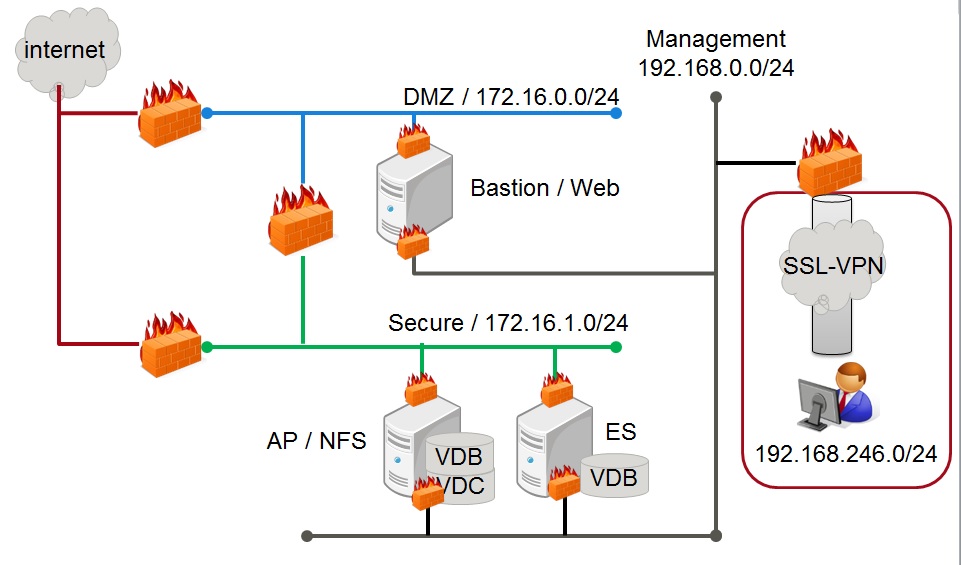This HeatTemplate automatically constructs the network and server configuration for Personium 3 Server unit in OpenStack.
- The operation confirmation is done by FUJITSU Cloud Service K5 of OpenStack base IaaS.
- The network connecting to the Internet and the SSL-VPN connection for server access are excluded from the creation of this HeatTemplate.
The configuration that can be created with this HeatTemplate is shown below.
| File name | Contents |
|---|---|
| 01_personium_network.yaml | Create networks and firewalls. |
| 02_personium_server.yaml | Create servers for Personium. |
I will explain the flow of creation using this HeatTemplate.
Create a KeyPair to log in to the server for Personium.
Edit 01_personium_network.yaml.
- Set the Availability Zone used for the default of availability_zone in the Parameters section.
availability_zone:
type: string
description: Availability zone
default: { Availability zone } # set Availability zone
Use 01_personium_network.yaml to create the network.
Connect DMZ network, Secure network, Management network to external network.
Edit 02_personium_server.yaml.
- Set the availability zone you are using to the default of availability_zone in the Parameters section.
availability_zone:
type: string
description: Availability zone
default: { Availability zone } # set Availability zone
- Network ID setting
Obtain the ID of the created network, and in the Parameters section Set to default of dmz_network_id, secure_network_id, mng_network_id.
dmz_network_id:
type: string
description: ID of the dmz network.
default: { dmz_network_id } #set dmz network id.
secure_network_id:
type: string
description: ID of the secure network.
default: { secure_network_id } #set secure network id.
mng_network_id:
type: string
description: ID of the management network.
default: { management_network_id } #set management network id.
- KeyPair setting Obtain the name of the created KeyPair and in the Parameters section Set to web_server_key_name, ap_server_key_name, es_server_key_name default.
web_server_key_name:
type: string
description: Name of web server key.
default: { your_server_keyname } #set server KeyPair name.
ap_server_key_name:
type: string
description: Name of ap server key.
default: { your_server_keyname } #set server KeyPair name.
es_server_key_name:
type: string
description: Name of es server key.
default: { your_server_keyname } #set server KeyPair name.
- Certificate setting Edit the user_data of the web_server in the resources section according to the certificate you are creating.
web_server:
type: OS::Nova::Server
properties:
--Omission--
user_data_format: RAW
user_data:
str_replace:
template: |
#!/bin/bash -v
--Omission--
openssl genrsa 2048 > /root/ansible/resource/web/opt/nginx/conf/server.key
openssl req -new -key /root/ansible/resource/web/opt/nginx/conf/server.key << EOF > /root/ansible/resource/web/opt/nginx/conf/server.csr
{ Country Name } # set country name
{ State or Province Name } # set state name
{ Locality Name } # set locality name
{ Organization Name } # set oganization name
{ Organizational Unit Name } # set oganization unit name
{ Common Name } # set common name
{ Email Address } # set mail address
{ A challenge password } # set password
{ An optional company name } # set company name
EOF
openssl x509 -days 3650 -req -signkey /root/ansible/resource/web/opt/nginx/conf/server.key < /root/ansible/resource/web/opt/nginx/conf/server.csr > /root/ansible/resource/web/opt/nginx/conf/server.crt
openssl genrsa -out /root/ansible/resource/ap/opt/x509/unit.key 2048 -outform DER
openssl req -new -key /root/ansible/resource/ap/opt/x509/unit.key -out /root/ansible/resource/ap/opt/x509/unit.csr << EOF
{ Country Name } # set country name
{ State or Province Name } # set state name
{ Locality Name } # set locality name
{ Organization Name } # set oganization name
{ Organizational Unit Name } # set oganization unit name
{ Common Name } # set common name
{ Email Address } # set mail address
{ A challenge password } # set password
{ An optional company name } # set company name
EOF
openssl x509 -req -days 3650 -signkey /root/ansible/resource/ap/opt/x509/unit.key -out /root/ansible/resource/ap/opt/x509/unit-self-sign.crt < /root/ansible/resource/ap/opt/x509/unit.csr
Create an SSL-VPN connection to the Management network.
Follow the steps below to set up Personium. ansible/3-server_unit
